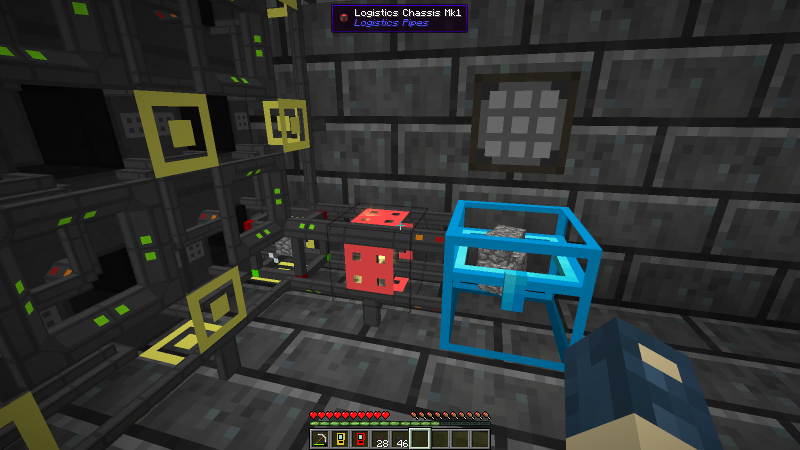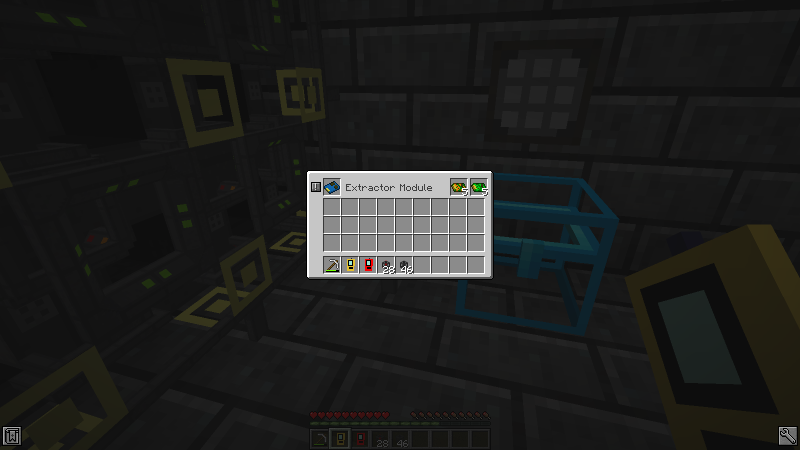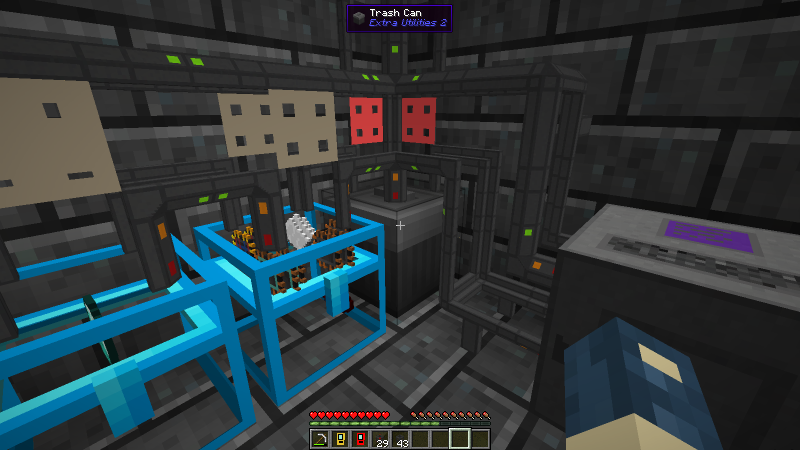Logistics Pipes Tutorial Part 5 - Managing Items with Modules
In this part of the tutorial we use more types of modules to improve our item management.
Upgrades
After returning home from a log mining trip one of the first things we want to do is empty our inventory out. Hoppers work great for this, but they only pull from their tops and they are not especially fast at moving large numbers of items. Let’s build an Extractor Module, which constantly pulls items out of whatever it is attached to and injects them into the LP network to be sunk somewhere. Then we just need to craft a Chassis, attach that Chassis to a chest, and add that module to it. Now we can dump everything that we want to get rid of into this chest and it will make its way into the network.
Out of the box, this module actually runs more slowly than a hopper, extracting one item every five seconds. We can improve this with Item Extraction Upgrades, which increase the number of items it extracts each time, and Action Speed Upgrades, which increase how frequently it runs. I tend to use five or six Action Speed Upgrades and a few more Item Extraction Upgrades for this sort of item-dumping chest, but they can go as high as 16 of each if necessary. Remember that extraction uses power.
We can’t use the Pipe Controller to add these upgrades since we need to add them to the Extractor Module, not the Chassis. Instead, we need to craft a Module Upgrade, an upgrade that, when installed into a Chassis, gives us slots to add upgrades to individual modules. After adding that to the Chassis we can grab the Pipe Manager, open the Chassis, and add modules in the new slots that appeared on the right.
Item Extraction Upgrades also work on Provider and Crafting Pipes. This can be useful when something needs to request an enormous quantity of something, as the extraction speed of the pipe itself can otherwise be a bottleneck. The same goes for Provider and Crafting Modules.
Item Sink Priority
When an item enters the network and more than one pipe can serve as a sink for it the network uses a list of priorities to decide where it is needed most:
- Passive Supplier Modules
- Item Sinks, including Basic Pipes and all ItemSink Modules
- Terminus Modules
- Default routes
Passive Supplier Modules are largely a relic from the time before Active Supplier Modules existed. They attempt to keep a certain number of an item in stock, but unlike Supplier Pipes and Active Supplier Modules, they will not request them from the network. Instead, when an item a Passive Supplier Module needs enters the network it will sink that item before anything else has a chance to do so.
Terminus Modules, with their lower-than-normal priority, usually serve as a means of getting rid of excess items once storage for it fills up. A LP network will frequently have a Terminus Module that sinks excess cobblestone and dirt into a trash can, matter condenser, or even pool of lava so that it doesn’t fill up the default route’s storage.
Re-sorting Items
Supplier Pipes, Crafting Pipes, and similar things are notably absent from the list above. Supplier Pipes do not sink items when they enter the network because they use active routing, which can only request items from providers. By contrast, Basic Pipes and other item sinks do not request items because they use passive routing, which means they can only respond to items entering the network that need a place to go.
This dichotomy can become a problem for the default route. Even if it has a provider attached to it, the default route may not empty itself out over time; there is no priority system for providers. If the default route runs out of space then the network will begin spilling items onto the floor. This is where the QuickSort Module, along with a little attention on our part, can come in handy.
A QuickSort module inspects the items it has and looks for somewhere else on the network that can sink it that is not a default route. If it finds one it injects it back into the network so the network can re-sink it. This is a valuable way to keep a default route chest clean – when storage becomes available for something the QuickSort module sees to it that it goes elsewhere. Let’s put this into practice by upgrading our default route’s Mk2 Chassis to Mk3 and then add a QuickSort Module to it.
With this setup in place we can check the chest periodically to see if anything is building up. If it is then we can take one out of the chest, place it in a chest with a Polymorphic sink, and the QuickSort Module will quickly move the rest of that type of item over. Or we can add it to a Terminus Module somewhere and have the QuickSort Module send it there for disposal. Or we can do something more involved. This combination of modules makes for an efficient and easy-to-manage system for item storage.
QuickSort Modules are also great alternatives to Extractor Modules for a factory’s post-outing, item-dumping chest. They have the added benefit of not extracting items that have nowhere other than the default route to go, which makes it immediately obvious when something is in need of storage. In fact, in most of my factories the default route and the item-dump chest are one in the same.
A word of warning: do not place a QuickSort Module in the same place as an item sink unless that item sink is a default route. If you choose to ignore this warning, do not do so more than once in a given network or the QuickSort Modules will endlessly trade items with one another.




